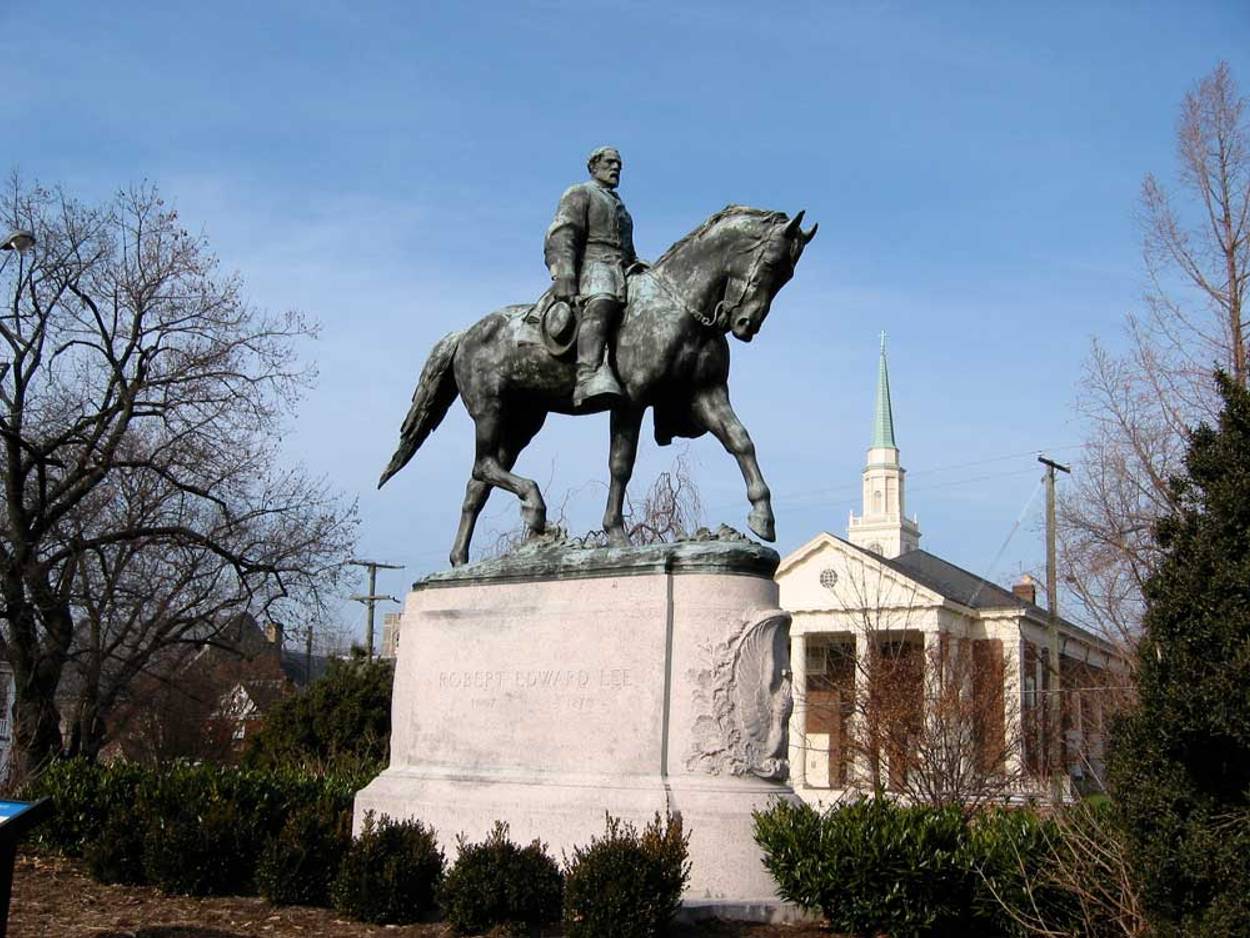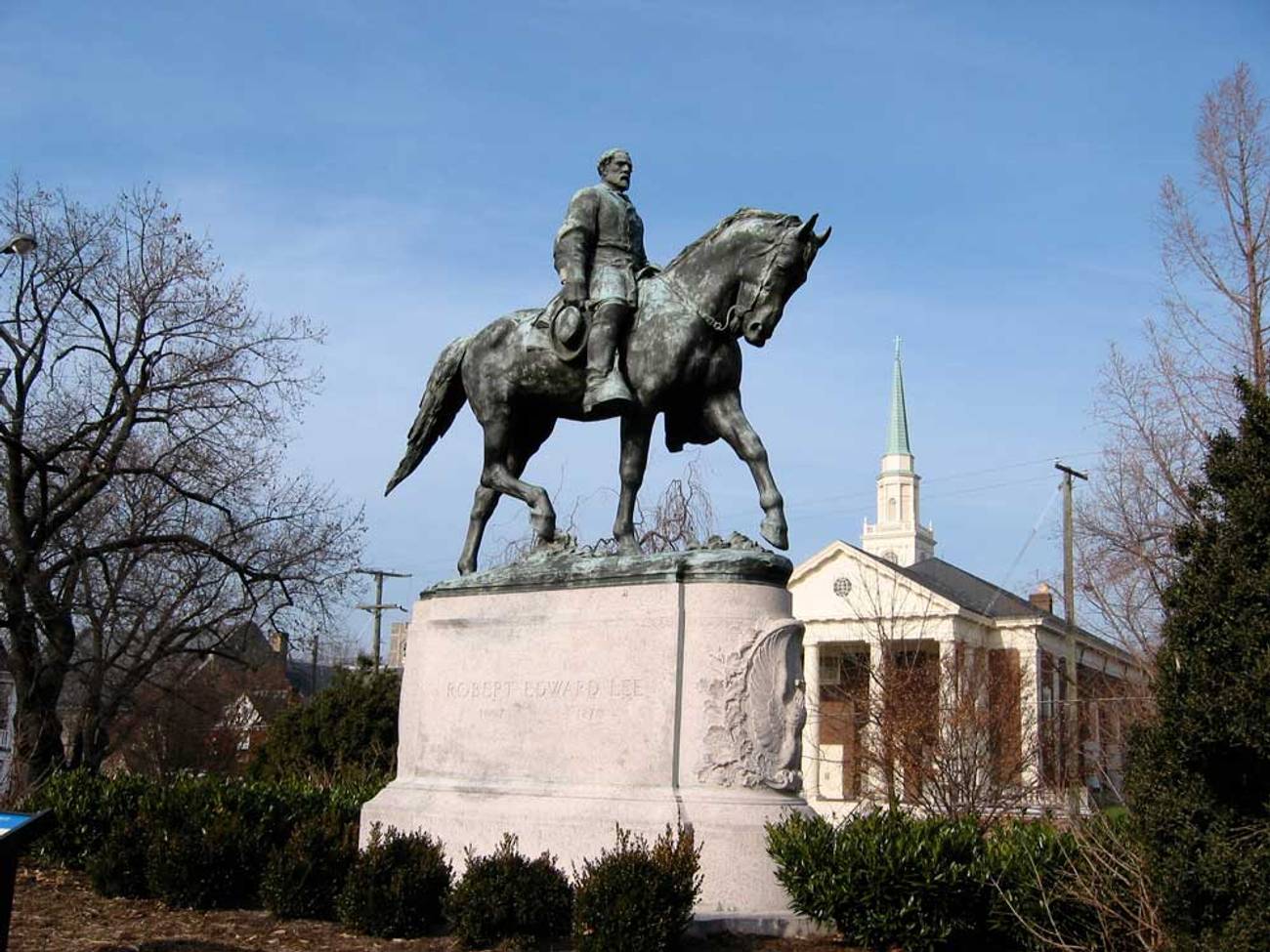How Charlottesville Broke the Peace
The South already lost the Civil War. Why are Trump’s opponents so interested in restarting it?

Wikipedia

Wikipedia

Wikipedia

Wikipedia
Last month, officials at Washington & Lee University removed the headstone at the burial site of Traveller, a horse whose famous rider, General Robert E. Lee, served as president of the school after leading Confederate forces in the Civil War. After complaints from alumni and others, another headstone was substituted for it—one without Lee’s name or that of the United Daughters of the Confederacy, who dedicated the memorial in 1971.
On social media, some users mocked activists for having gone so far as to target animals deemed “racist,” but the impulse to pick on Lee’s steed signals something dark. Americans are famously sentimental about animals. The easiest way for moviemakers to communicate a character’s cruelty is by showing them mistreating one. Desecrating the grave of a pet verges on pathological evil—and fixating on one associated with the Civil War is like casting a spell to stir spirits that will once again set Americans at each other’s throats.
In Charlottesville, Virginia, six years ago Sunday, protests turned violent, leading to the death of a counter protestor, Heather Heyer, who was killed by a car driven by a hate-addled racist. The weekend began with a Friday evening coming together of far-right groups that marched through the city with tiki torches. The following day, the Unite the Right rally was held at a monument to Robert E. Lee in Emancipation Park, where violent clashes between protestors and counter-protesters led to a melee in the streets and Heyer’s murder.
At a press conference two hours later, President Donald Trump condemned “in the strongest possible terms this egregious display of hatred, bigotry and violence, on many sides. On many sides.” Two days after his initial statement, which was criticized for being too vague and not adequately condemning white supremacy, Trump issued a follow-up: “As I said on Saturday, we condemn in the strongest possible terms this egregious display of hatred, bigotry, and violence. It has no place in America,” the statement continued: “Racism is evil. And those who cause violence in its name are criminals and thugs, including the KKK, neo-Nazis, white supremacists, and other hate groups that are repugnant to everything we hold dear as Americans.”
At an Aug. 15 press conference, Trump was asked to elaborate on his earlier statement about the violence coming from “many sides.” The press wanted a blanket denunciation of those protesting removal of the Lee statue—the murder victim was among the counterprotesters, the side the press represented to the public. But video showed that leftist gangs had come prepared to engage their right counterparts in a street-violence set piece, so Trump observed there were troublemakers on their side, too.
“You had a group on one side that was bad,” he said. “And you had a group on the other side that was also very violent.” He then added, a bit later on in the conversation, “I’ve condemned neo-Nazis. I’ve condemned many different groups, but not all of those people were neo-Nazis, believe me. Not all of those people were white supremacists by any stretch.” Trump reiterated this point moments later. “There were very fine people on both sides,” he said.
Rather than acknowledge Trump’s condemnation in a spirit of national unity—surely condemning Nazis was one of the few things Americans could still agree on—senior Democrats acted as if it had never happened. The press went along with the charade, giving birth to one of the essential myths of the past decade and establishing a durable political formula. Ignoring evidence in order to draw a line from Trump through his supporters to slaveholders and nazis seemed absurd, except it worked well enough that in 2020, Joe Biden made his opposition to Trump’s response to Charlottesville a centerpiece of his presidential campaign.
The outraged reaction to the president’s statement kicked off what Trump supporters call the “very fine people” hoax. And yet this manipulation of the truth barely mattered to those who long before that August day saw the reverence of Lee as a token of racism. For them there couldn’t be fine people on the other side since anyone arguing to preserve a monument to a Confederate general was, by definition, a racist, and their existence proof that race-hate still courses through American society.
Rather than acknowledge Trump’s condemnation in a spirit of national unity—surely condemning Nazis was one of the few things Americans could still agree on—senior Democrats acted as if it had never happened.
Whether Lee was a traitor, too, as the same cohort claims in order to build their case for excising him from American history, is a question best left for historians of the constitution. What’s clear is that, in the wake of the Civil War, if the government of the United States had designated everyone who fought for the cause of secession as traitors, there would have been no peace. Rather than go to the gallows, Confederate officers would have chosen to wage the guerilla war that Lee warned against. Accordingly, the vanquished were largely allowed to melt away and enjoy the record of their valor and the respect of their kinsmen.
Today, many of the people opposed to removing and destroying the remaining Confederate monuments argue that they should stand as permanent reminders of America’s darkest moment, when brother fought brother. But another way to understand them is not as emblems of conflict but rather as the ornaments of our peace, giving form to the formula by which the United States was reunified after nearly being torn apart. Trump’s comments after Charlottesville, despite being decried as a dangerous incitement, merely restated the terms of peace that served to hold the country together after the Civil War: There were bad people, for sure, but there were also very fine people, on both sides. Rejecting those terms by insisting on the absolute evil of everyone on the Confederate side, to the point that no statues to their war dead can be allowed to stand, is the true threat to our peace.
The “very fine people” episode is a crucial piece of the traitor narrative Obama initiated shortly before he left office. In December 2016, he directed his CIA chief John Brennan to produce an intelligence report that officially endorsed the Democrat-funded conspiracy theory that Vladimir Putin helped Trump win the 2016 race. The purpose was to delegitimize Trump’s presidency and Trump supporters: In voting for someone who had betrayed their country to a foreign power, they, too, were traitorous.
The 2020 Democratic candidate, Obama’s vice president, picked up the thread. Charlottesville, said Joe Biden, was the reason he decided to run. Charlottesville was the first word out of his mouth when he announced his candidacy in April 2019. With the proposition that “there were ‘some very fine people on both sides,’” according to Biden, “the president of the United States assigned a moral equivalence between those spreading hate and those with the courage to stand against it. And in that moment, I knew the threat to this nation was unlike any I had ever seen in my lifetime.”
Charlottesville became the campaign’s main chord and Biden struck it when he wanted to show that Trump was disloyal to America. He told a reporter that because Trump failed to “condemn white supremacy, the neo-Nazis, [he] has no basic American values—he doesn’t understand the American code.”
As president, Biden continues to provoke racial division along party lines. He warns African American audiences of “white nationalist” terror, a threat exaggerated by his domestic spy chiefs to justify rounding up Trump supporters and spying on Catholics and school parents opposed to the regime’s efforts to divide families and communities by weaponizing race and gender.
Charlottesville was in the background of the George Floyd riots in the spring and summer of 2020. With the political support of Democratic Party bosses and the financial backing of corporate elites, the purpose of the riots was to show that Trump’s America was divided by race and to dare him to take strong measures to stem the violence and thereby give proof that he’s both a racist and an authoritarian.
98 Confederate monuments were removed in 2020--more than the amount removed in all other years combined. Some were destroyed by vandals, but the majority were removed peacefully, either with the consent of local representatives or by executive decree. It was part of a larger revision of U.S. history to ground the Obama faction’s version of reality in the past, and thus the Civil War was used as a platform to rationalize an assault on political opponents. Framing Trump as a “white nationalist” sympathizer implicates the half of America who voted for him as racists. It places them in league with the Confederacy in a war that is no longer understood as having been fought between brothers but is reconceived as a battle between good and absolute evil.
With Trump indicted for, one, charges related to the January 6 “insurrection” and, two, a classified documents case under the Espionage Act, he and his supporters are wrapped up in the “traitor” narrative.
What we may learn from Civil War monuments is that it’s best, sometimes, to leave it where it lays, let the dead bury their dead and then let’s move on together. The lesson Charlottesville and the traitor narrative teach is different: Losing a war, or an election, leaves you vulnerable to a campaign of desecration rationalized by a pathological political faction waving the banner of social justice. May the ghosts of annihilation pass us by.
This story has been updated to correct editing errors that confused details of the rally.
Lee Smith is the author of The Permanent Coup: How Enemies Foreign and Domestic Targeted the American President (2020).